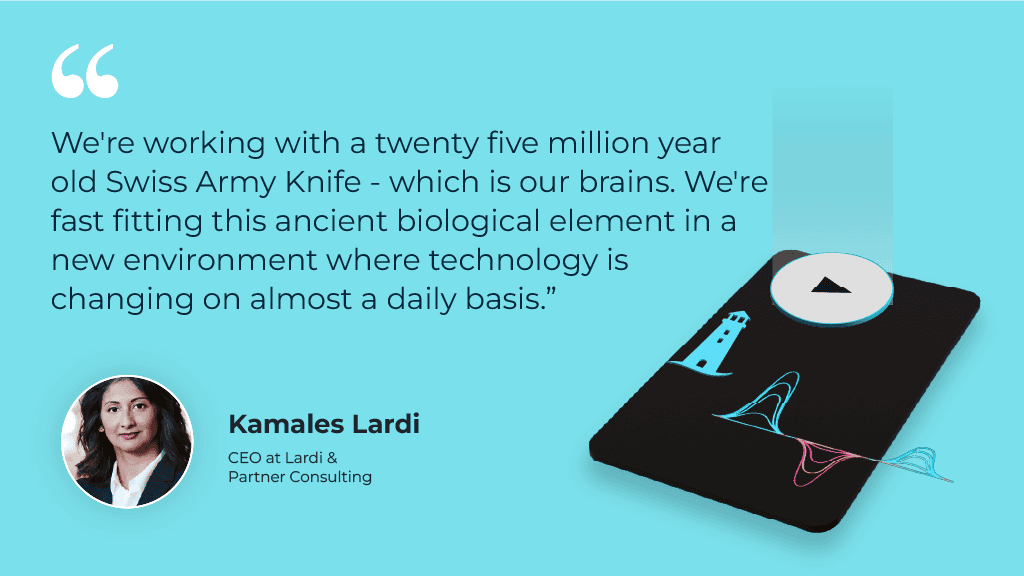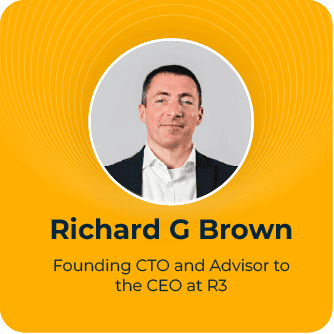
In this episode of The Digital Lighthouse, host Zoe Cunningham is joined by Kamales Lardi, CEO at Lardi & Partner Consulting, to discuss The Brain Code and how leaders can use neuroscience to break through resistance, foster trust, and build a truly human-centric approach to digital transformation.
Join them to discuss:
- How the brain’s response to uncertainty mirrors physical pain
- Why traditional change management often fails by coming too late in the transformation process
- The neuroscience behind effective storytelling and its role in driving organizational change
- How to balance AI automation with human judgment in decision-making
If you enjoyed this episode, please subscribe so you don’t miss an episode. We would also appreciate a few moments of your time to rate and review on Apple Podcasts and Spotify; we value all feedback from our listeners to deliver the best content and experience.
Listen here:
Watch here:
Episode Highlights:
- [04:02] – Why our brains resist change
- [07:59] – Recognising the warning signs in teams
- [11:12] – Harnessing the power of the Social Brain
- [14:06] – Balancing AI automation with human intuition
- [18:55] – Adopting human-centric success metrics
- [22:36] – The future of human-centric digital organisations
About our guests

Kamales Lardi
CEO at Lardi & Partner Consulting
Kamales is a globally recognized digital strategist and award-winning author. With over 25 years at the forefront of digital transformation, she has helped organizations from Fortune 500 companies to governments successfully integrate emerging technologies with a human-centric approach. Her unique expertise combines neuroscience with digital strategy, bridging the gap between technological advancement and human psychology. As the author of “The Human Side of Digital Business Transformation,” Kamales focuses on helping organizations overcome resistance to change, foster trust, and achieve sustainable digital transformation while maintaining the human element.
Transcript
[Zoe Cunningham] (0:01 – 1:45)
Hello and welcome to the Digital Lighthouse. I’m Zoe Cunningham. On the Digital Lighthouse, we get inspiration from tech leaders to help us to shine a light through turbulent times, so that we can learn, act and change as a result for the benefit of our businesses.
We believe if you have a lighthouse, you can harness the power of the storm. Today, I’m delighted to welcome Kamales Lardi.
Kamales is a globally recognised digital strategist, award-winning author and CEO of Lardi and Partner Consulting. She’s been at the forefront of digital transformation for over 25 years, helping organisations, from Fortune 500 companies to governments, integrate emerging technologies in a way that truly centres around people. Her work uniquely combines neuroscience with digital strategy to drive business success without losing the human touch.
So in today’s conversation, we’re diving into something crucial, the brain code. How leaders can use neuroscience to break through resistance, foster trust and build a truly human-centric approach to digital transformation. We’ll be discussing everything from AI ethics and leadership in disruption to the future workforce and the biggest digital blind spots companies need to watch out for.
So Kamales, welcome to the Digital Lighthouse. Thank you.
[Kamales Lardi] (1:45 – 1:46)
It’s a pleasure to be here.
[Zoe] (1:47 – 1:57)
To kick things off, could you maybe tell us a bit about your journey and how you’ve ended up at this kind of fascinating intersection of technology, business and neuroscience?
[Kamales] (1:58 – 4:02)
Absolutely. So I started my journey out as a coder, you know, hardcore tech development in the late 90s. And I started off like any other technologist, really believing that technology was the silver bullet solution for the future of companies, survival of companies.
I was really passionate about the transformative potential, especially as we moved more into kind of the mid 2000s and late 2000s when we started to really see disruptive technologies transform industries. But I think one of the key learnings I had over the last 25 years is really just observing how organisations take on transformation and implementation of tech and struggle, the struggle around how well these implementations happen, how well they are adopted within organisations, the key challenges. It always centred around an element that could make or break transformation and technology application.
This was really the human factor. And so my observations really led me into down this rabbit hole to really try and understand why these lessons are not being learned over the decades. Why are organisations still struggling with these elements?
So if we look at our current statistics, over 70% of digital transformation initiatives still fail. All fall short of the intended outcomes. And we’re still kind of going in this repetitive cycle.
And so one of the things that I did was deep dive into the human element and going into that space as a technologist was very challenging. I had to let go of my own beliefs, but it was so valuable to kind of fully understand the human element and then to understand that at the centre of organisations, at the centre of technology, is really the people, customers, employees, stakeholders, owners, this kind of ecosystem of humans that impact how technology works. And that took me a little bit deeper into understanding neuroscience.
So how people think, how the brain works and what motivates us and how our emotions and our thoughts actually can drive success in technology application. And so this is kind of the journey that I took over the last two decades.
[Zoe] (4:02 – 4:19)
Amazing. Well, let’s start with talking about the neuroscience. So what does research tell us about how our brains react to digital change?
And then how can leaders use that neuroscience to help make transformations more effective?
[Kamales] (4:19 – 7:10)
So there’s a lot of in-depth research around the impact of change and uncertainty on people. And one of the key elements around that is really change has a very similar or uncertainty has a very similar impact on human beings as physical pain. So when we are in a situation of constant uncertainty and constant fear or change, we feel it like it has the same impact on our well-being as being in chronic pain.
If I give you an example, let’s say you come into the office on a Monday morning, you walk over to the coffee machine, you’re getting your coffee, your normal morning routine. A colleague rushes over to you and says, hey, you know what? I heard the company is going to implement AI.
It’s going to affect jobs. There’s going to be job cuts. I don’t know when. I don’t know how many people are going to be affected, but it’s coming. So I wanted you to know that person walks away. So what happens to our brains immediately?
We go into sort of this amygdala response, the fight, flight and fear kind of freeze response where our brain interprets that information as a threat and tells our body you’re under attack. And so immediately the hypothalamus kicks in and rushes our body with cortisol, which is our kind of survival mode. And it prepares us to, you know, in kind of the biological sense to react to fear, protect ourselves.
So we go into sort of this defensive mode. And this is the reaction just to a ruler. And if you think about that consistent change and uncertainty that we face within organisations, transformation initiatives, digital implementations can last a year, two years. It can go on for a while as long as the company is kind of implementing these change initiatives. And so we as human beings within those environments are in this constant survival mode, which puts us into a defensive mode. And so we are not receptive to change.
There’s no innovative thinking. There’s no creative thinking. It’s all about survival. How do I keep my head down and survive this change? And that’s not an ideal environment to implement technology because people are not going to be open to this new way of doing things. And so once we understand this reaction, we also understand change management that traditionally companies take on comes in the very end of the process.
After you’ve done strategic development, you’ve done kind of designing and development of your solutions, and then you go into this change management where you say, let’s train people, let’s communicate the change, let’s do engagement strategies and so on, which is far too late in the process because we know from the brain’s reaction, as soon as we hear something’s changing, we go into survival mode. And so you’ve had this longstanding reaction and defensiveness that exists and coming in when change management at the very end doesn’t have a sufficient impact on people. And so once leadership teams understand this process and the impact, they will be able to use effective strategies to ensure this process is more successful.
[Zoe] (7:10 – 7:40)
I think that’s a really good analogy as well, because the kind of vision I get is like, you’re saying that going through this long, uncertain change management process, it’s kind of like being in this post-apocalyptic world where there’s no food and you’re fighting for something. It’s kind of like if you chucked all your employees out into the wilderness for two years and then they came back and you were like, great, now give us your best creative thinking so that we can do this together. That analogy makes it really clear to me why that’s not going to work.
[Kamales] (7:40 – 7:59)
Absolutely. If I can just share another part on that. We’re working with a 25 million year old Swiss army knife, which is our brains. We’re fast fitting this ancient biological element in a new environment where technology is changing on almost a daily basis. So there’s a disconnect there that I think leadership teams need to kind of reconcile.
[Zoe] (8:00 – 8:12)
Are there any kind of more specific, like cognitive triggers that leaders can be aware of and watch out for, either avoiding or perhaps using positive stimuli to help employees through these changes?
[Kamales] (8:12 – 11:12)
So there are kind of three different areas that we tend to focus on when we look at digital transformation specifically. There’s the cognitive element, which is the individual. So focussing on how individuals react to change.
And then there’s the kind of the team environment or the kind of social element. So we call it the social brain. And there’s actually a part of your brain, connected set of the brain that’s actually called the social brain, where we as human beings are built or designed to have this social connection. And the more social positive connection we have, the stronger this element in the brain becomes. And then there’s the environmental aspect as well.
And so for leadership teams, trigger signs and warning signs that they can look for is low productivity, low morale. And you see this a lot in transformation initiatives, where people kind of react. They go through this kind of cycle of very similar to the grief cycle. And it’s kind of very, very eye opening to watch this happen as well.
People go into this denial mode and then they kind of go into a status of freeze, where I don’t react and I don’t take on any more information. And then you have a subset of people who say, this is too much change and I’m going to leave. So if you start looking at lowered retention or turnaround of employees increasing, the lowered morale and you start also seeing the negative or toxicity.
So people starting to gossip and there’s an increase in negative information flow, things like that. So these are some very strong warning signs of triggers that leadership teams can keep an eye on. But if you’re doing transformation well, you’ve already addressed this at the very start of the process.
And one of the things I always help leadership teams start with is connecting to the purpose. So if we think about there’s a lot of conversation around purpose of transformation, purpose of technology implementation and all of that. But looking at a higher purpose is very important.
So if I give you another analogy to connect with, if we look at places that have had natural disasters or places where we’ve had fires or we’ve had earthquakes, communities of people tend to come together despite their own personal loss to rebuild and to help one another, because they’ve got now a connection to a higher purpose. I’ve lost my home, but I want to help the community rebuild our town. And so if we take that same principle and we think about individuals within organisations in a change process can become very isolated and disconnected.
And so bringing a higher purpose and connecting them to that and saying we are an organisation that serves a purpose in the market. And in order to serve that purpose better, we’re using X, Y, Z technology. So that communication and that way of connecting to purpose is really important.
And it can give people a symbol of why I exist here, why I need to go through this pain in order to come out the other side. And there’s a positive for me as well as the organisation and the customer. So this is something I try to get leadership teams to connect with very early on in transformation.
[Zoe] (11:12 – 11:56)
Yeah. So this is what I love about neuroscience, because I think that it’s a really good way of confirming and explaining what we can sense intuitively as people. And so this kind of aspect of the social brain that I think I’ve heard talked about before, like we have sympathetic neurones, so they literally fire.
That’s how close our connections are with other human beings. And actually, as soon as you say there’s a social brain, you’re like, oh, well, of course, a way to help people through transformation is to have strong interpersonal relationships with your colleagues and to be there for each other. And like you just said, support each other through the change and work together rather than trying to deal with it on your own.
[Kamales] (11:56 – 14:03)
Absolutely. And I think these are some of the revelations, the reasons behind or the why behind what we do that makes so much sense for me. So over the years, we’ve always looked at purpose of technology.
We’ve always looked at another great example would be storytelling. We’re always told in the business world use storytelling, but nobody ever explains why storytelling works and how to use that storytelling and storytelling. And there’s actually really great research.I think he’s called Professor Uri Hasson from Princeton. So he’s done a really fantastic piece of research and he’s got a TED talk on this topic as well, where there’s proof that the listener’s brain, when you’re telling a story, the brain activity synchronises with the speaker’s brain. And when this synchrony happens, they connect to sounds, patterns and narratives and it connects on a very emotional level.
And when there’s this synchrony, there is this mutual understanding, mutual empathy and this connectivity then creates a space of psychological safety and it creates a space where people connect emotionally. And we all know behaviour change happens when people are connected emotionally rather than from a logical side, it comes from an emotional side. And so if you want as a leader to drive your organisation, to nudge them towards a positive direction for change or transformation, storytelling can be extremely powerful.
Coming from a perspective of connecting with other people and getting that brain synchrony so that people are really understanding why things happen, why we’re doing what we’re doing. And they connect with that emotionally and that emotional connection can create huge loyalties within organisation. And it can be so effective for customer base as well, because your customers then connect to your brand on a very emotional level.
So we’re seeing companies like Coca-Cola and Harley-Davidson has done a fantastic job of that as well. And these types of brands have been so effective in it that you see, you know, Harley-Davidson, for example, is the most tattooed brand in the world. So I would really like to imagine a world where we have people walking around with tattoos of banks.
[Zoe] (14:03 – 15:17)
Can you imagine if you loved your bank that much? So I love thinking about technology in a human-centric way. And I love talking about how amazing the human brain is, because I think a lot of people, particularly with all the talk nowadays around AI, I think that lots of people think that AI is better than our brains or could be better than our brains.
And that’s something that I personally, I’m not convinced by that argument. But let’s move on to talk about AI, because I think it’s important to think about it in this context. And one area where there’s growing concern is this balance between automation, which the benefits of automation are super clear, you know, taking the cognitive load off humans that doesn’t need to be and is done somewhere else.
So you’ve got this balance between automation and kind of outsourcing to technology. But then on the other hand, you’ve got human intuition. And when we’re doing the task ourselves, we’re obviously guiding that with our own intuition in a way that once we outsource it can be more challenging.
So how do we ensure that AI driven decision making doesn’t erode our critical human judgement?
[Kamales] (15:18 – 18:06)
So Zoe, this is a debate and a discussion I’m having with most leadership teams that we’re engaging with at the moment. There’s this huge debate in the market of can we replace workforce with AI for cost reduction purposes, particularly also in the consulting industry. We’re having, I think, ChatGPT has come out with their latest model that’s going to be equivalent to a PhD student that could replace consultants within organisation environments.
For me, it’s a very interesting point because it isn’t about replacing people. And this is the point I try to get across. It’s about supplementing or, to a certain extent, converging with what we can do. And I think if we look at AI transformation from three aspects, there are systems that can, at the very basic level, do things faster than us as humans. So it makes sense to utilise the systems because it can be more efficient, it’s quicker. And there’s a huge kind of business value related to that.
The next element is it can do things that are better than us. So it takes that cognitive level to the next step. And only because it has, in my view, I think there’s a crowd that would debate me on this, but in my view, because it has access to more data, it can process that data quicker and it can connect the dots much faster than an average person. Hence, it can do certain tasks better than us. And then there’s the third part where it can perform activities without us. So we’re not needing so much the human involvement.
So we’re not talking about oversight here, but we’re talking about involvement in completing a task. So here we’re looking at agentic AI and to a certain extent, what we’re seeing is a hype in the market at the moment. So within organisations, it’s important to assess where you want to apply AI and how it could benefit the business across the board.
But where I see human value definitely not being replaced is obviously the oversight element, making sure that those technologies are working in the way we want it to work and having enough of an understanding of how those technologies work, that we can make sense of that output and we can spot when the output isn’t making sense. I think this is where companies are not focussing enough, where there is a certain amount of algorithmic trust, where we think if it’s done by AI, it’s got to be correct. And this is where the human element is so important because we need to be able to spot those trigger signs or those early warning signs that tell us it’s not correct.
We have to dig deeper into that. If we think about AI being very much a black box, if we’re talking to someone, so let’s say you’re in a leadership discussion and you’re talking to another person or a CEO and he says, I’ve decided X, Y, Z. He can talk you through his thought process and reason with you and say, I’ve connected this data and this intuition, this experience, and I’ve come to a decision. And we tend to want leadership teams, we tend to want people to justify how they make decisions, but we don’t ask that of AI.
[Zoe] (18:06 – 18:16)
I was just going to say, to go back to what you said earlier, the CEO can tell a story of how they made their decision and hence get your brains in sync and make that connection, right?
[Kamales] (18:16 – 18:55)
Absolutely. But you see, we don’t demand that of AI systems. And oftentimes, I do find 9 out of 10 people that I speak to in the corporate world, they are using ChatGPT. But if you challenge them a little bit more and say, why do you trust this output? Where does this information come from? How did it come to that output? There is very little understanding. And I think this drop or this increase in knowledge gap that we’re seeing around AI and the increase in trust, that’s going to be a bit of a challenge for people to address. So organisations need to keep that human element very much in the centre of how they apply AI within organisations or within your business.
[Zoe] (18:55 – 19:28)
Yeah, well, let’s move on to talk about a very universal aspect of business that is perhaps leading to some of these decisions. So most organisations measure transformation success through financial metrics. So that’s the primary metrics that organisations are using. So from a human centric perspective, how should companies redefine what success looks like in a digital initiative to maybe take account for some of these other aspects of the transformation that we’re just discussing?
[Kamales] (19:28 – 21:49)
I love that you’re focussing on kind of the metrics element, because I think oftentimes it’s one of the last, it’s an afterthought for companies. And as you said, the focus is very much on the financial outcome or the tangible outcomes. We implement AI, we get X, Y, Z, business benefit reduction, cost reduction, increase in profits, X, Y, Z.
It’s problematic to a certain extent, because that could also mean if I replace 10 employees with two AI systems or two instances of AI, I get X benefit, right? But you’re losing that human element, that kind of experiential knowledge that they’ve built over time, the intangible elements within the organisation. So I always focus back and we start this at the very beginning of transformation, where we define the purpose and value that the organisation wants to achieve.
So we don’t start with use cases, where we say, okay, in X, Y, Z department, you could apply these technologies. But we start with what’s your business challenge? Are you in a shrinking market? Are you looking at expanding across regions? Are you looking at needing to put out more products and services because it’s very competitive? Or you need to be more unique in the market and so on.
So we start with the business challenge, with an outlook of where you are today, where you want to be in the future as well. And that defines the measures that we’re going to sort of define, right? And that connects to essentially in companies, it connects to four key areas. It’s your growth and scale, productivity and efficiency, risk management and experience or superior experience. But it also comes down to looking at your company DNA. What values do you stand for?
Are you an organisation that wants to be seen in the market as the best place to work? That could be something you measure as well. If you increase efficiency, that impacts the experience employees have.
And so we really connect our measures and metrics to the business value or business challenge you want to achieve. And the corporate organisational values that you stand for as a company. And many times we actually go through the process with companies to pinpoint what your values are.
And so as a transformation expert or technology expert, we go back into the area of kind of defining values and really understanding what the organisation represents in the market at the very beginning. And that is used then to define key metrics around how the transformation work happens.
[Zoe] (21:49 – 22:03)
Yeah. So essentially, you’re making sure you’re going back to this holistic approach and making sure you’re taking in everything about the organisation. Because we all know that there’s no organisation that’s single dimensional. There’s so much to consider.
[Kamales] (22:03 – 22:35)
Yeah. And it might sound like a very overwhelming process or over engineered. But we have methodologies and many of them that I created over the years based on my experience that helped to accelerate that process as well.
It helps break the process down into kind of more manageable pieces as well. So it works within larger organisations as well as small, mid-sized companies. And it allows us to kind of based on how mature or where the company is in terms of their digital maturity, we can pick and choose as well which elements of the framework that we apply to that organisation.
[Zoe] (22:36 – 23:06)
So all of these topics are so fascinating. And I could talk about this literally all day. We could just keep going and do a whole day podcast.
But just finally, I want to make sure I get on to talking about your book, The Human Side of Digital Business Transformation. And in your book, you lay out a vision for the next generation of organisations. So if we fast forward a decade, what does a truly human centric digital business look like?
And what radical shifts do leaders need to be making today so that we can build that future?
[Kamales] (23:07 – 25:26)
This is a great question. How I would envision a company for the future that’s truly human centric would be organisations that are built around the people and the value they create for the market. At the very centre of this organisation would be truly the people, the employees, the ones kind of delivering complex kind of human touchpoint services to the market.
And automation and various technologies being utilised to take over kind of redundant work. So I would say, and this is something I’ve tried to build for myself as well as an organisation, trying to create a company that works with the life or lifestyles and personal development of individuals. So we have hyper personalised working models, for example, where employees can actually design their work life balance based on where they are in their personal life as well.
But delivering towards the company and creating value towards the company. This can sound very challenging for some organisations. This is completely out there, but it works.
And it works because there is a different leadership style. I think the leadership style of the kind of dramatic change I’d like to see today is this leaders focussing on creating psychological safety within organisations. Having that open, transparent communication and connection to people.
Also having a very strong kind of touchpoint to the market. I would say about six out of 10 top level, C-level executives that I speak to have not in the last two years had a direct touchpoint to a customer. So how do you run an organisation that serves the customer if you’re not talking to your customers, right?
And this doesn’t mean you have to go down to your kind of shop and talk to someone, but have that kind of human connection. And I don’t think it’s such a bad idea to have that kind of once in a while go down and kind of talk to the people and have this engagement. And so this kind of breaking barriers and one key element I would say is abundance thinking is going to be very important.
Thinking beyond the current business landscape, thinking beyond the current limitations of business and exponential technologies is fantastic. But also thinking beyond the kind of physical business environment and go into exponential abundance thinking or mindset. The world of business today is not what it was 10 years ago.
And so we need to change with that time. So there we go.
[Zoe] (25:27 – 25:40)
Another five topics. I should talk about any of those topics for a whole podcast. But unfortunately, that is all that we’ve got time for.
So thank you so much, Kamales, for coming and opening all these doors for us. And thank you, everyone, for listening. Thank you.



